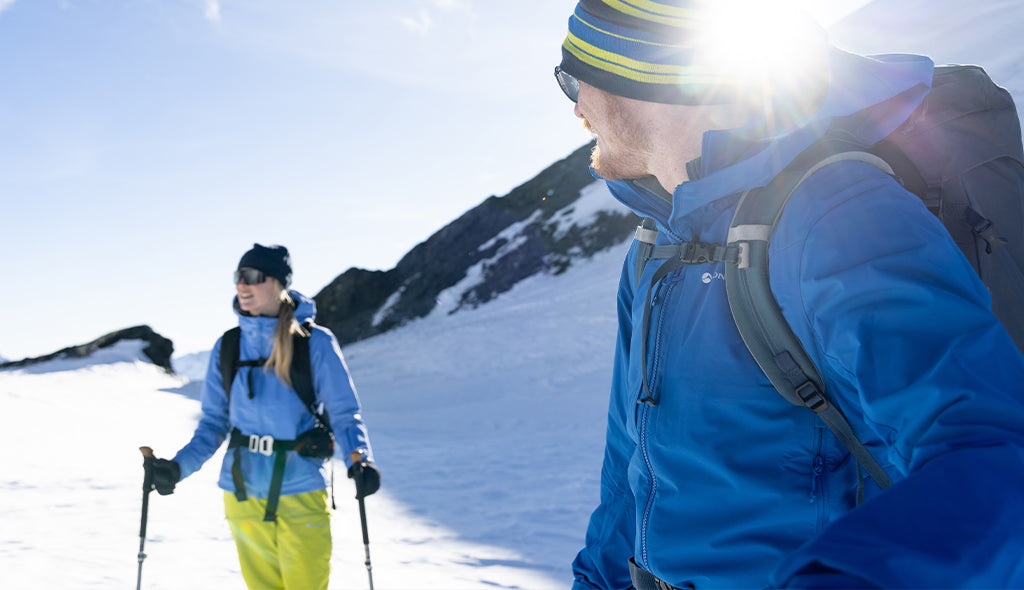The Cold Weather Layering System
Looking for fast and light layers that help you move efficiently and achieve your goals? Here are the basics that you need to know to build your own layering system for cold weather...

Looking for fast and light layers that help you move efficiently and achieve your goals? Here are the basics that you need to know to build your own layering system for cold weather...

When building the best layering system for cold weather, when the rain has turned to snow, the priorities shift away from fending off the downpour and towards staying warm, but not overheating and sweating. In extremely cold environments such as the Arctic, or after dark in the Alps, sweating under warm layers can be very dangerous, because the sweat tends to freeze on the inside of your layers as you cool down.
The basics of layering remain the same, and you still need a breathable base layer, a lightweight midlayer and protective outer layers – just because the rain has turned to snow doesn’t mean the wind can’t strip away all your body heat, even if it’s not that cold.
The difference when building a layering system for very cold weather is that you need an additional warm layer in your pack to throw over your main outer layer if you have to stop for a spell, at a belay stance on a climb, or during a break in a long-distance trek. Here’s how the layering system for very cold weather fits together…

Above: Montane Women's Dart Long Sleeve T-Shirt
Your baselayer for very cold conditions should ideally be long sleeved and have the ‘thermal’ tag, meaning it’s designed specifically for below-zero temps, and is often sold in a set with thermal leggings. The same general rules for baselayers given above apply here, and breathability remains vital because of the denser layering system for very cold conditions.

Above: Montane Men's Alpine 850 Nano Hooded Down Jacket
Your layering system for cold weather can be very tuneable if you focus on your breathable midlayer. You have options here because you can go for a lightweight fleece, a wind-resistant insulated softshell or a high-performance lightweight down jacket, cut to fit under protective outer layers. The most advanced down midlayers are constructed to minimise bulk and weight but maximise warmth, while also offering windproof protection. This means that they can double up as excellent technical outer layers for warmer, drier seasons.

Above: Montane Women's Anti-Freeze XT Hooded Down Jacket, Montane Women's Torren Waterproof Jacket
The first thing to know about layering for very cold weather is that you need to pack more than one protective outer layer. The workhorse that you will likely be wearing all the time is a waterproof jacket. Even though the threat of rain has receded, a durable waterproof hardshell is still the best protection you can get against snow, icy winds and freezing rain, because your body heat can melt the snow into water. Another viable option is a water-resistant and windproof softshell, which can stretch with you as you move and will be more breathable if you’re working hard.
If you’re in very cold, sunny conditions, such as ski touring at altitude then you can also consider softshell pants, because these will breathe exceptionally well. Otherwise, high-quality waterproof shell pants are the go-to here because they are designed to be both extremely protective and breathable. For high very high-altitude mountaineering, or polar expeditions, down salopettes are the gold standard for warmth.
Finally, the last thing you want to do when trying to stay warm is let cold air into the microclimate between your skin and your outer layer. This means carrying an ‘instant warmth’ down hoodie or artificially insulated jacket in the top of your pack, ready to throw on over the top of your main protective jacket when you stop.

Above: Montane Alpine Resolve Waterproof Glove
Protecting your extremities becomes crucial in sub-zero temperatures where the danger of frostbite is real. It might sound strange to have a layering system for your hands, but it’s not uncommon for winter climbers to carry multiple pairs of gloves, with spares, ranging from thinner breathable gloves for the walk in, natural or synthetic leather-palmed ones for climbing with axes and thick waterproof gloves and mittens for maximum warmth on a belay. A lost glove can be a nightmare and even waterproof gloves that get wet from melting snow or ice may keep your hands dry, but you still loose heat, so always carry spares in your pack. Warm beanies and neckwear or balaclavas that fit under helmets are essential in minus temps, and warm socks are vital – you might want to double up or wear breathable sock liners to reduce moisture build up and blisters (again, carry spares).
Check out our full guide to the layering system for the perfect combination in any weather conditions.